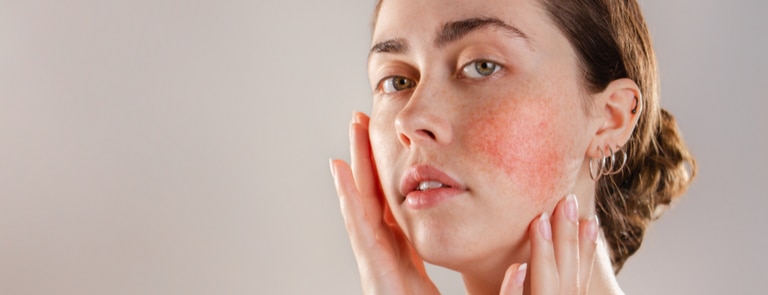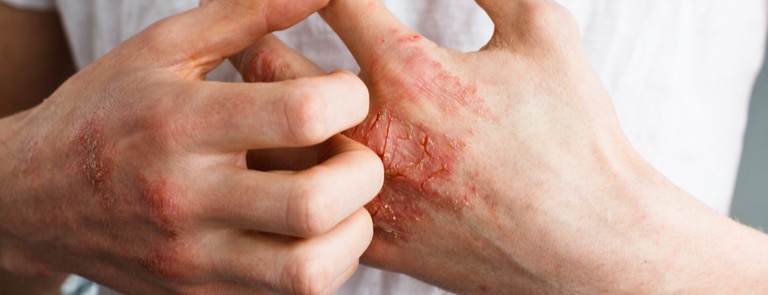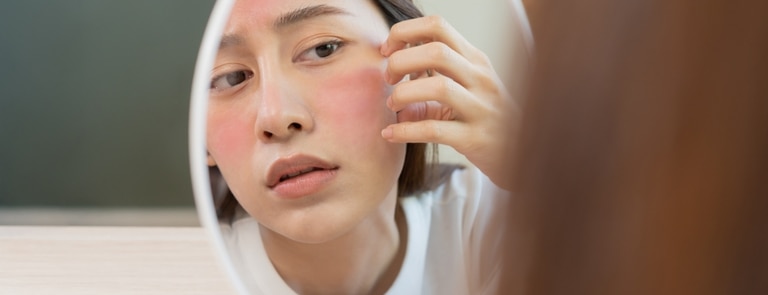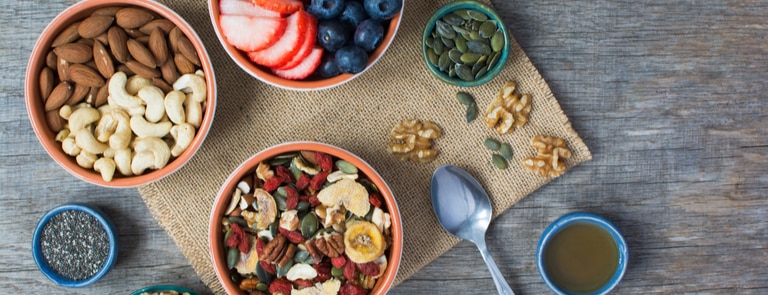Skin microbiome: The gut-skin connection
Our skin is precious. There’s also more to it than first meets the eye too.
The skin on our body and on our face is unique to us; we have our own unique fingerprints and we all have different skin combinations – i.e. some of us may have sensitive skin on our arms or parts of our faces, some may have oily skin and some catch the sun easier than others.
Additionally, others may have skin conditions, such as eczema, rosacea, psoriasis or acne, and so on…
All in all, everybody’s skin makeup is different, just as our eye colour, our hair colour and texture and facial features all differ.
But how often do we stop to think about this fact?
To pause for a minute and think about what our skin, that outermost layer that protects us throughout our entire lives, is actually made up of?
It’s not something many of us think about every day, but that doesn’t mean it’s not worth pondering for a minute or two.
Thanks to the likes of Dr Michael Mosley and The Clever Guts Diet, most of us are aware of the microbiome that exists in the gut, but how many of us are clued up about our skin microbiome?
Skin microbiome, or skin microflora, is just an interesting subject as the gut microbiome. Let’s delve a bit deeper and spend the next few minutes focusing on the skin’s microorganisms.
In this article, you’ll find out
- What the microbiota of the skin is
- What it does
- The skin-gut connection
- What a healthy skin microbiome looks like
- Things that affect it
- 3 skin conditions linked to gut issues
- How to look after your skin microbiome
- Mythbusting the skin microbiome
What is skin microbiome?
According to British Association of Dermatologists-accredited consultant dermatologist, Professor Carsten Flohr, skin microbiome is a community of organisms that live on the skin that includes bacteria, viruses and fungi.1
It’s this special ecosystem that’s responsible for ‘controlling’ our skin. For instance, how well it absorbs products and responds to certain ingredients.
Just as there can be bad bacteria present in the gut, bad bacteria can also be found on our skin – reportedly 1,000 different bacterial and up to 80 different fungi species.
This is where the crossover with skin and gut microbiome continues too, as some of the bacteria that’s in our gut, such as Staph, Strep, and Candida, can also be found on our skin.2
Before we move on, it’s also worth mentioning here that skin microbiome also goes by the name of ‘skin microbes’ or ‘skin flora.’
What does skin microbiome do?
Our skin microbiome, which we all have, is responsible for doing quite a bit actually.
First and foremost, it’s responsible for protecting our skin and balancing out our skin’s natural PH value.
As well as protecting our skin, it ‘gives’ a lot to it too.
For instance, by producing nutrients and lipids that help contribute to our skin’s overall health which, in turn, can make it look and feel healthier.3
Could spotty skin be linked to your gut?
Bothered by spots on your face or body?
You might not think that acne is connected to what’s going on in your digestive system, but evidence now suggests that gut issues could be an underlying cause of spots.
Acne and gut health
There haven’t been any large-scale clinical studies into the link between acne and increased gut permeability, and it’s probably not something your GP would mention as a potential cause of skin problems.
But some experts, such as functional medicine doctors – alternative medicine experts who look at the underlying causes of disease – believe there is a strong connection.
A new area of medical research has also started to explore what’s called the ‘gut-skin axis’, in a bid to understand how digestion can interact with and affect your skin. 4

Is there a leaky gut link?
A major review of studies published in the journal Gut Pathogens in 2011 found evidence that the gut lining may be more permeable than usual in people with acne.5
Your gut is lined with a layer of proteins, meshed together in so-called ‘tight junctions’ at particular points.
But in some people, it’s thought the links between the proteins become too loose, allowing foreign substances through the gut lining and into the bloodstream.
The review in Gut Pathogens showed people with acne are more likely to have certain toxins in their bloodstream, indicating what’s known as a ‘leaky gut’ – this may be because the toxins cause inflammation, leading to spots.
How ‘friendly’ bacteria could help
The 2011 review concluded that taking beneficial bacteria supplements may be useful for people with acne.
These can help replenish levels of good bacteria in your gut, which may play a role in reducing inflammation.
Also, a healthy community of gut bacteria can help your body release nutrients from food, which help strengthen the gut lining.
This could potentially heal a leaky gut and ease spotty skin, although more clinical research is needed.
What is a healthy skin microbiome?
Generally speaking, a healthy skin microbiome means that it has a good skin bacteria balance, including various different microorganisms that work together in harmony.
This will show itself through un-problematic, healthy-looking skin.
A healthy skin microbiome will also act as a barrier that protects against invading pathogens.6
What affects the skin microbiome?
There are multiple things that can affect the skin microbiome. But let’s start off with the things you have little control over.
These include:
- Your age
- Your sex
- Your environment7
The things that you may be able to control, that affect the skin microbiome, include:
- Your job
- Your clothing
- Your medication
- Your cosmetic products
- Your weight
- Your diet8,9
3 skin conditions linked with gut issues
Read on to find out more about the 3 skin conditions that are linked to gut issues
-
Psoriasis

Psoriasis affects 2-3% of people in the UK and 120 million people worldwide, making it the most common autoimmune disease.
Its exact cause has never been pinned down, but new research suggests the gut might have a key role to play…10
What is psoriasis?
It is an autoimmune disease.
This means the immune system mistakenly launches an attack against the body’s own tissues, triggering an inflammatory response.
In psoriasis, this response causes skin cell production to go into overdrive. Excess skin cells build up in patches called plaques.
Plaques are usually red, flaky, crusty and covered in silvery scales. They’re often sore and itchy, too. The condition can also affect the joints, causing swelling, stiffness and pain (known as psoriatic arthritis).11
What does the gut have to do with it?
Scientists think that the microbes or bacteria that live in the gut play a key role in keeping the immune system in order, telling it when and when not to attack.
Some microbes seem to promote inflammation, while others suppress it.
People with psoriasis tend to have fewer different kinds of gut bacteria – with lower levels of anti-inflammatory bacteria and higher levels of pro-inflammatory bacteria.12
A 2016 study found higher levels of E. coli (which has been blamed for conditions such as inflammatory bowel disease) and lower levels of F. prausnitzii (thought to be crucial to intestinal and general health).
The study’s author suggested that ‘the skin might function as a mirror of the gut’ in people living with psoriasis.13
Can bacteria help?
Could ‘good’ bacteria be the answer? Research suggests that introducing ‘good’ bacteria can help restore the gut’s balance of anti-inflammatory and pro-inflammatory bacteria.
In a 2013 study, the bacterial strain, B. infantis 35624, reduced measures of inflammation in those with this autoimmune disease.
Conventional treatments for this condition work by suppressing the immune system’s anti-inflammatory response.14
However, this can impair the body’s ability to fight real infections and is not always effective.
A 2012 study reported on the case of a woman with treatment-resistant pustular psoriasis who was given ‘good’ bacteria Lactobacillus supplements three times a day.
Her symptoms began to improve within two weeks and within six months, the marks on her skin were gone. If in doubt: go with your gut.15
-
Eczema

Eczema is a skin condition that causes dry, cracked, itchy skin. It usually develops in early childhood, but some cases can develop in adulthood too.16
Scientists are now starting to explore the link between eczema and the microbiome, but more on that later.17
What is eczema?
As we mentioned, this is a common inflammatory skin condition where the skin gets red, irritated, bumpy and itchy – and it may be more noticeable at night.18
It is not known exactly what causes eczema, but some believe that it is caused by an over-reactive immune system – a bit like with psoriasis.19
What does the gut have to do with it?
Since 70% of the immune system is in the gut, it might be a sign that the two are more related than you might think.20
Earlier in the article, we talked about how the skin microbiome acts as a barrier to protect your skin.
Interestingly, research published in 2018 found that the barrier of people with eczema doesn’t work as well to keep harmful bacteria out, and instead, some does seep in.21
Can bacteria help?
Like with psoriasis, ‘good’ bacteria (or probiotics) have been proposed by experts as an effective treatment for eczema, and this treatment is increasing as more clinical trials are taking place.22
-
Rosacea

According to the NHS, rosacea is a long-term skin condition that primarily affects the face.
It’s most common in women and in people with lighter skin, but symptoms can sometimes be worse in men.23
What is rosacea?
Rosacea is a very common skin condition that usually starts with frequent blushing of the nose, cheeks, forehead and chin – as well as a burning sensation when your face comes into contact with water or skincare products.24
There are a number of different factors that are linked with rosacea, such as genetics, skin colour and the immune system – noticing a theme here?25
What does the gut have to do with it?
You may be starting to notice that the immune system, the gut and the skin are all linked. Scientists have found that people with acne-like rosacea tend to react to a certain bacteria (bacillus oleronius), which causes the immune system to overreact.26
Also, a large clinical study from 2016 found that a high percentage of adults with rosacea also had gastrointestinal disorders like irritable bowel syndrome, inflammatory bowel disease and celiac disease.27
Can bacteria help?
Since diet may impact rosacea through the gut-skin connection, scientists have advised that working on a healthy gut microbiome by going on a fibre rich, prebiotic diet could be the way forward.28
What can we do to look after our skin microbiome?
How can we protect something we can’t see and don’t really think about on a day-to-day basis? Do we even need to?
Absolutely!
As we established a bit further up, the microbiome on our skin is responsible for a lot and so it’s important that we look out for it as best we can, which will enable it to continue to do its job well.
There are several things we can all do to nurture skin and give it the TLC it deserves.29
For instance, we can:
- Eat a healthy, balanced diet and stay hydrated – there’s a link between our skin microbiome and immune system, therefore eating the right food and drinking enough fluids can help make sure our gut and skin bacteria stay happy 30
- Steer clear of trigger foods – e.g. dairy, gluten or sugar
- Take care of your gut microbiome too – one of the ways you can do this is by eating a microbiome diet and taking prebiotics and probiotics
- Don’t be OTT with hand sanitising – this can actually unsettle your skin’s natural PH balance. Just like with washing our hair, it pays to not over wash your skin!
- Try to stay calm – i.e. be as stress-free as possible, which may be easier said than done, but stress can negatively impact our bodies in so many ways, skin included
- Stay active – regular exercise can help lower stress levels, as well as potentially help us to lose weight, sleep better and generally be more fit. It can even boost our gut health too.

Busting 5 skin microbiome myths
There’s a lot of information out there about the skin microbiome, and that’s only online….
For instance, if you were to Google ‘skin microbiome’, like we just have, you’ll be presented with no less than in the region of 11,800,000 results.
Now, that’s a lot of skin microbiome information!
But how can you tell which bits to pay attention to and what not to pay attention to? What’s the definitive truth and what’s not 100% right?
It can be difficult to know the difference between the two when there’s such a vast amount of information to read through.
To help you out, and to help set the record straight about the skin microbiome, we’ve taken some of the most common myths and debunked them for you.
Take a look, we’ve listed five of them below:
-
MYTH #1: Skin microbiome doesn’t really do very much
Fact – Now this couldn’t be further from the truth!
The skin’s microbiome is a real force to be reckoned with. It’s essentially a powerful ecosystem that’s designed to help keep your skin in check and healthy. Now, for the science bit….
Skin microbiome is made up of diverse colonies of microorganisms, including bacteria, fungi and viruses.
Many of these microorganisms are harmless and, in some cases, provide vital functions, such as helping to preserve the balance on your skin.31
-
MYTH #2: We’ve all got the same skin microbiome
Fact – We haven’t at all.
Our skin microbiome is as unique to us as our fingerprints.
In fact, human skin microbiomes have been described as a ‘microbial fingerprint’ due to how different they are from one person to the next.
Skin microbiome is thought to be shaped by our lifestyle and genetic predisposition.
This is especially true for the epidermal microbiome (the outermost layers of our skin).
Interestingly, the skin microbiome that’s present deeper down within the skin, at the dermal layer, is said to be ‘universal’ between healthy individuals.32
-
MYTH #3: Skin microbiome has got nothing to do with gut microbiome
Fact – This is an easy assumption to make, as the bacteria inside our gut is tucked away deep down inside our bodies and the microbiome on our skin is well, present on our skin.
However, this doesn’t mean they aren’t interlinked, because they are.
Our skin bacteria and skin immune system actually ‘talk’ to each other and communicate with the bacteria living in your gut too.
Just like with your gut, having a diverse balance is the key to a happy skin microbiome.33
-
MYTH #4: Our skin microbiome becomes unbalanced on its own
Fact – Our everyday lifestyle habits, in particular our cleaning habits, play a big part in settling, and unsettling, the natural state of our skin microbiome.
Having hot showers and taking baths every day, increased washing generally and using ingredient-packed products that strip the skin of its natural oils can quickly result in our skin microbiome getting out of sync.
This is due to something that’s known as transepidermal water loss, which can result in moisture escaping from the skin.
How can you tell if your skin microbiome balance isn’t quite right? Your skin can become dry, irritated or red.34
-
MYTH 5: There’s nothing we do to help our skin microbiome do its job
Fact – There’s actually a whole lot of things we can do.
In fact, a lot of what we do on a day-to-day basis influences the state and overall condition of our skin microbiome.
Here are just some of the skin microbiome-boosting habits worth taking note of:
- Be gentle to your skin – by using products that help protect and preserve your skin’s PH and its microbiome while you wash. I.e. use products that are 100% gentle and are as mild to skin as water35
- Stay hydrated – it’s no secret that staying hydrated can really help our skin overall, skin microbiome included
- Think about your gut microbiome – it’s important to give your gut microbiome some TLC if you can as this may support your skin microbiome36
- Exercise – as we all know, staying active and taking part in regular exercise can help us to stay healthy, as well as sweat out toxins and contribute towards better skin health overall37
Feeling a bit more clued up about skin microbiome now?
Well, now you can hopefully distinguish between some of the myths and some of the real truths about what is your skin’s microbiome and how it functions.
As you’ve most probably realised by now, skin microbiome is literally a whole world in itself that can influence how your skin looks and feels.
The key, as with most of the inner workings of our body, is taking the time to consider yours and trying to understand what makes your personal skin microsystem tick.
A few final words about skin microbiome…
It may seem a bit odd, the thought of lots of little microorganisms all working away on the surface and within the layers of our skin to enable it to function better and remain healthy.
But, from a top-level perspective, it’s exactly what’s happening every day, to us all.
Our skin microbiome is essentially our very own skin superhero, so make sure you take the time to consider yours and the impact your lifestyle and the way you treat it.
For instance, the products you use could be affecting your skin hero, who’s there by your side, regardless of how we treat it and what we throw at it, inside and out.
Understanding the importance of a healthy gut
Ever suffer with bloating or discomfort but don't know why? Despite having 100% the same DNA Lisa and Alana Macfarlane (The Mac Twins) only have 30-40% of the same microbiota, in this episode we look at:
- Why gut health is so important?
- How your gut health impacts more than just your digestion
- Ways to fit wellness into your day
Sources
- https://www.vogue.co.uk/article/skin-microbiome
- https://www.mindbodygreen.com/0-23996/your-skin-microbiome-why-its-essential-for-a-healthy-glow.html
- https://www.dove.com/uk/stories/tips-and-how-to/washing-and-bathing-tips/an-introduction-to-skin-microbiome-from-dove.html
- http://onlinelibrary.wiley.com/doi/10.1002/bies.201600008/abstract
- https://www.ncbi.nlm.nih.gov/pmc/articles/PMC3038963/
- https://www.nature.com/articles/nrmicro.2017.157
- https://www.ncbi.nlm.nih.gov/pmc/articles/PMC3535073/
- https://www.ncbi.nlm.nih.gov/pmc/articles/PMC3535073/
- https://www.sciencedirect.com/science/article/pii/S2452231719300120
- https://www.nhs.uk/conditions/psoriasis/
- https://www.nhs.uk/conditions/psoriasis/
- https://www.ncbi.nlm.nih.gov/pmc/articles/PMC3744517/
- https://atlasofscience.org/psoriasis-more-than-a-skin-disease-the-involvement-of-gut-microbes/
- https://www.ncbi.nlm.nih.gov/pmc/articles/PMC3744517/
- http://www.odermatol.com/wp-content/uploads/file/2012%204/9_Pustular%20psoriasis-Vijayashankar%20M.pdf
- https://www.nhs.uk/conditions/atopic-eczema/
- https://onlinelibrary.wiley.com/doi/abs/10.1111/ajd.12435
- https://kidshealth.org/en/parents/eczema-atopic-dermatitis.html
- https://nationaleczema.org/beyond-the-eczema-rash/
- https://www.ncbi.nlm.nih.gov/pmc/articles/PMC2515351/
- https://www.ncbi.nlm.nih.gov/pmc/articles/PMC5911439/
- https://www.ncbi.nlm.nih.gov/pmc/articles/PMC6517242/
- https://www.nhs.uk/conditions/rosacea/
- https://www.nhs.uk/conditions/rosacea/
- https://www.aad.org/public/diseases/rosacea/what-is/causes
- https://www.aad.org/public/diseases/rosacea/what-is/causes
- https://pubmed.ncbi.nlm.nih.gov/27501017/
- https://www.ncbi.nlm.nih.gov/pmc/articles/PMC5718124/
- https://www.mindbodygreen.com/0-23996/your-skin-microbiome-why-its-essential-for-a-healthy-glow.html
- https://www.mindbodygreen.com/0-23996/your-skin-microbiome-why-its-essential-for-a-healthy-glow.html
- https://www.ncbi.nlm.nih.gov/pmc/articles/PMC3535073/
- https://mbio.asm.org/content/11/1/e02945-19
- https://www.vogue.co.uk/article/skin-microbiome
- https://www.vogue.co.uk/article/skin-microbiome
- https://www.dove.com/uk/stories/tips-and-how-to/washing-and-bathing-tips/an-introduction-to-skin-microbiome-from-dove.html
- https://www.mindbodygreen.com/0-23996/your-skin-microbiome-why-its-essential-for-a-healthy-glow.html
- https://www.mindbodygreen.com/0-23996/your-skin-microbiome-why-its-essential-for-a-healthy-glow.html